

DEPARTMENT OF ELECTRICAL AND COMPUTER ENGINEERING 2023 ANNUAL REPORT
10% of seniors are enrolled in the BACHELOR’S ACCELERATED MASTER’S (BAM) program
Professor MISSY CUMMINGS one of U.S. Navy’s first female fighter pilots and head of Mason Autonomy and Robotics Center (MARC)
ANOUSHEH ANSARI, ECE alumna first female private space explorer and first Muslim woman in space
ECE department is home to the LARGEST SATELLITE DISH in the Washington D.C. area
RANKINGS on the rise-computer engineering ranked 38 among public universities, #64 nationally

BACHELOR’S 495 Computer Engineering 275 Electrical Engineering 220 197 MASTER’S 70 Computer Engineering 55 Electrical Engineering 52 Digital Forensics 20 Telecommunications DOCTORAL 78 FULL-TIME
FULL-TIME STUDENTS
FACULTY 34
2 1 3
Department Highlights .................................................................................. 1 Letter from the Chair 3 Research Grants ........................................................................................... 4 SECTION: RESEARCH OF CONSEQUENCE Living Lab Pumps Up Power Research 6 Student Team Wins Defend the Republic 8 Faculty Firms Up Future G 10 Missy Cummings Seeks to Address Challenges in AI 12 SECTION: EDUCATIONAL INITIATIVES ECE Ramps Up Support for Tech Talent Investment Program 14 New Clean Room and Microfabrication Concentration 16 Data Center Engineering 18 A Recipe for Success: Mixer Blends Students, Alumni, and Industry Leads 20 SECTION: STUDENT ACCOMPLISHMENTS Bold Move Puts Goldwater Scholar on the Right Path 22 Aspiring to Smoother Traffic 24 Engineering for Good: Students Design a System to Detect Landmines 26 Student Profile: Dinesh Karri 28
 Electrical& Computer Engineering
Electrical& Computer Engineering
Since 2015, the Electrical and Computer Engineering (ECE) Department of the College of Engineering and Computing has been publishing a bi-annual newsletter. Starting this year, we are very excited to bring you an annual report featuring in-depth articles about new program initiatives, faculty accomplishments, awards, and recognitions.
As I write my inaugural letter, I see five very exciting areas of growth for the department. The first is POWER AND ENERGY under the leadership of Liling Huang. With the push for a carbon-free grid powering a carbon neutral economy, there will be large investments in this area along with a large demand for students having a strong background in power and energy, and the department is positioning itself to take advantage of this.
The second area is ELECTRONICS that is being fueled by the SEMI-ASA Initiative partnership, the 2022 CHIPS and Science Act, and the Nano-IMAGINE program funded through the GO Virginia initiative. With a new clean room on our Sci-Tech campus in Manassas along with a full-time nano-fabrication manager, we are looking to expand our electronics program and give our students valuable experience in a clean room.
The third is ROBOTICS, that cuts across many departments in the college and involves units outside the college. In this report you will read about the Lighter Than Air (LTA) Defend the Republic competition that was held in April, with the Mason team winning the competition. These LTA robotic blimps occasionally make an appearance in the Atrium and at student recruiting events to the awe and excitement of everyone. Other exciting things include hiring new faculty in robotics, the million-dollar investment in a robotics lab, and the creation of a new Mason Autonomy and Robotics Center (MARC). Not to be left out are innovative projects in bio-inspired underwater robotics, swarming, robotic hands with tactile sensing, robotic eyes, and human-robot interactions.
The fourth emerging area is QUANTUM COMPUTING. The creation of the Quantum Science and Engineering Center involving faculty in physics, mathematics, and electrical engineering along with the Quantum-Classical Computer-Aided Design Lab led by Weiwen Jiang, will position the department to play an important role in exploring high-risk high-reward research projects, to develop some interesting courses in the area of quantum computing, and to collaborate with others throughout the university.
The final area is SPACE. With the ribbon cutting of the 9.1-meter dish in December of 2012, the department continues to make progress on programs and initiatives in space under the leadership of Peter Pachowicz. With the successful launch of the ASTERIA ThinSat in 2020 and an expected launch of LunaSat to the moon in 2024, ECE students have much to look forward to. Other space initiates include a Small Satellite Engineering graduate certificate and a SatCom ground station.
You will get to read about all of these and much more in this report. We hope you enjoy reading this report as much as we enjoyed writing it!
Sincerely,
Monson Hayes, ScD Professor and Chair
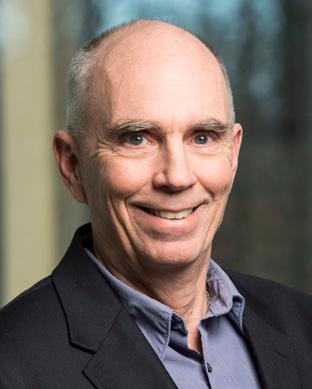
3
Monson Hayes
3
Research Grants
Our faculty research continues its forward momentum with total expenditures in 2022 exceeding $4M and 36 awards of greater than $100K, sponsored by federal agencies like the National Science Foundation, DARPA, Office of Naval Research, Army Research Office, Air Force Research Laboratory, and private industry such as Intel Corporation. This research positions ECE as a valuable contributor to overall growth in research and development at the college and university levels.
Kaps (Co-PI), Reza Azarderakhsh (Co-PI, FAU), and Mehran Mozaffari Kermani (Co-PI, USF)
CORE: Medium: Collaborative: Countermeasures Against Side-Channel Attacks Targeting Hardware and Embedded System Implementations of Post-Quantum Cryptography Algorithms
Research: BRIDGES: Binding Research Infrastructures for the Deployment of Global Experimental Science
Houman Homayoun (Co-PI, UC Davis)
Abu-Ghazaleh (UCR), Samet Oymak (UCR)
CORE: Medium: Targeted Microarchitectural Attacks and Defenses in Cloud Infrastructure
Medium: Approximate Computing for Machine Learning Security: Foundations and Accelerator Design
NextG Cryptography for Power Constrained
Insulator Field Effect Transistors for Memory and Sensors
Gas Sensors for Spacesuit Monitoring
Qiliang Li Patrick Vora (PI), Karen Sauer (Co-PI), Erhai Zhao (Co-PI), Dimitris Ioannou (PI)
Sai Manoj Pudukotai Dinakarrao Houman Homayoun (Co-PI, UCD)
Sai Manoj Pudukotai Dinakarrao Fadi Kurdahi (Co-PI, UCI), Houman Homayoun (Co-PI, UCD)
Sai Manoj Pudukotai Dinakarrao Haiying Shen (Co-PI, UVA)
Brian Mark Khaled Khasawneh (Co-PI), Sai Manoj PD (Co-PI) Kai Zeng (Co-PI)
Materials Center
CNS Core: Small: NV-RGRA: Non-Volatile Nano-Second Right-Grained Reconfigurable Architecture for DataIntensive Machine Learning and Graph Computing
EAGER: IC-Cloak: Integrated Circuit Cloaking Against Reverse Engineering
User Behavior-aware Real-Time Safety Enhancement in Vehicular Networks
EPIC SWaPD: Energy-Preserving IoT Cryptography for Small Weight and Power Devices
Brian Mark Tricia Chigan (UMass-Lowell) Collaborative Research: Intelligent Full-Duplex Cognitive Radio Networks for Pervasive Heterogeneous Wireless Networking
Brian Mark Yariv Ephraim (Co-PI) CIF Core: Network Tomography and Resource Allocation
Jill Nelson Kathleen Wage (PI) Building a Goal Reasoning Architecture for Cognitive Active Sonar
Voluntary Reduction In Force (VRIF)
DARPA
of Naval Research (ONR) $119,424
ECE Faculty Member Collaborators Title Sponsor Total Amount Xiang Chen Zhi Tian (Co-PI) MLWiNS:
Learning for
Monitoring National Science Foundation (NSF) $499,999 Xiang Chen – CAREER:
Pervasive
NSF $580,000 Xiang Chen Yiran Chen (PI,
Out-of-Distribution
Investigation Air Force Research Lab (AFRL) $130,000 Robert Elder Alex Levis (Co-PI) Comprehensive C2 Implementation Study AFRL $88,000,000 Robert Elder Alex Levis (Co-PI) Strategic Deterrence Frameworks SMA OSD (R&E), Joint Staff J39 $134,900,000 Kris Gaj
SaTC:
NSF $1,200,000 Kris Gaj Jens-Peter
Post-Quantum
National Institute of
and
$500,000 Bijan
Collaborative
NSF $2,036,291 Jens-Peter
Lightweight
Embedded Systems NIST $499,970 Khaled N. Khasawneh
SaTC:
NSF $1,200,000 Khaled N. Khasawneh
SHF:
NSF $1,200,000 Khaled N. Khasawneh Sai
Energy-Preserving
VRIF $100,000 Qiliang
Topological
NSF $360,000 Qiliang Li – Nanoengineered
NASA $258,000
Decentralized Heterogeneous Deep
Efficient Spectrum
Adapt, Learn, Collaborate—Closing the
Edge AI Loop with Liquid Intelligence
Duke)
Detection and Physical Adversarial Patch
Jens-Peter
Kaps (Co-PI)
Cryptography in Hardware and Embedded Systems
Standards
Technology (NIST)
Jabbari Jerome Sobieski (Co-PI)
Kaps Kris Gaj (Co-PI)
Cryptography in Hardware and
Neal
Manoj PD (Co-PI)
Devices
Li Dimitris Ioannou (Co-PI)
Hybrid
Quantum
GMU $2,000,000
NSF $600,000
NSF $300,000
$125,000
Kryptowire,
$1,603,064
NSF $481,956
NSF
$500,000
Office
4
Paris A. Molnar (Cornell U.), A. Al-Ghazaly (Cornell U.)
Correct Stigmergic Controllers for Enabling Emergent Behaviors in Swarms
Research: SWIFT: LARGE: Adaptive Interference Rejection with Synthetic Channel Diversity (AIR SynCD)
Integrated Measurement and Life Detection Sensing
Neuromorphic Physics-Informed Stochastic Regions of Attraction through Bayesian Optimization
Vector Symbolic Architectures for
and Collective Intelligence in Multi-Agent Autonomous
Tolga Soyata Kamaljeet Sanghera (PI, IST)
a Pipeline of AI Competency
and Robust Learning from Distributed
Zhi Tian Yue Wang (Co-PI), Lingjia Liu (Co-PI, VT), Yang Yi (Co-PI, VT) Securing Multi-Access Edge Computing Using Artificial Intelligence
Zhi Tian Lingjia Liu (PI, VT), Yang Yi (Co-PI, VT) SWIFT: Intelligent Dynamic Spectrum Access (IDEA): An Efficient Learning Approach to Enhancing Spectrum Utilization and Coexistence
Yue Wang (Co-PI)
Distributed Swarm Learning for Internet of Things at the Edge
Daigo Shishika (PI), Xuesu Xiao (Co-PI)
Team Behavior with Hierarchical Decision Making Using Game Theory and Learning
Yue Wang – CIF: Signal Processing and Learning for NOMA MillimeterWave Massive MIMO Systems
Contentions for Complex Control Systems with Shared Resources using Robust Model Predictive Control
Yao Daigo Shishika (PI, ME)
Kai Zeng Brian Mark (Co-PI), Edward Oughton (Co-PI, COS) Arthur Brisebois (Co-PI, Ericsson), Irwin Gerszberg (Co-PI, AT&T)
Kai Zeng Emmanouil M Tentzeris (Co-PI, GT), Saeed Zeinolabedinzadehn (ASU), Huacheng Zeng (Co-PI, MSU)
Kai Zeng Emmanouil M Tentzeris (PI, GT), Zheng Yan
Intelligence with Lighter-Than-Air Vehicles
NSF Convergence Accelerator Track G: Secure Texting Over Non-cooperative Networks and Anti-jamming Enhancement in 5G
Spectrum-Efficient, Bem-Agile, Interference-Resilient Millimeter Wave Communications with Reconfigurable Antennas and Intelligent Surfaces
Collaborative Research: NSF-AoF: CNS Core: Small: Secure Wireless Powered Backscatter Communication for IoT NSF, Academy of Finland
Privacy-Preserving and Trustworthy Spectrum Sharing Microsoft $100,000 Kai Zeng
Kai Zeng
Kai Zeng
Kai Zeng Sachin Shetty (PI, ODU), Tan Le, Duminda Wijesekera (Co-PI), Cong Shen, Jeff Reed, Vijay Shah
Kai Zeng Brian Mark (Co-PI), Lingjia Liu (Co-PI, VT), Changqing Luo (Co-PI, VCU)
Hardening Cybersecurity for mmWave Massive MIMO 5G Networks at Physical Layer
Secure 5G Wireless Networks Commonwealth Cyber Initiative (CCI), CCI Fellow
Secure and Privacy Preserving 5G Network for Connected Vehicles
Enhancing 5G Wireless Network Security with Reconfigurable Intelligent Surfaces
ECE Faculty Member Collaborators Title Sponsor Total Amount Cameron Nowzari – Development of
System ONR $751,667 Cameron Nowzari – The Cycle
ONR $510,000 Cameron Nowzari – Provably
ONR $275,659 Peter
NSF $220,000 Nathalia Peixoto – IMLDS:
Air Force, RheinTech Labs $224,770 Maryam Parsa Joe Hays
Learning
Intel Corporation $194,616 Maryam Parsa – Multi-Phase
Distributed
U.S. Army, Ground Vehicle
Center,
Research Center $378,000
Trench Analytics, U.S. CDAO $150,000 Zhi Tian – CIF:
Data NSF $423,100
VRIF $125,000
a Full-Scale LTA Swarm
of Emergence: Structure, Agency, and the Environment
Collaborative
System
(NRL)
Systems
Systems
Automotive
Developing
Communication-efficient
NSF $750,000 Zhi
NSF $400,000 Kathleen Wage – Random Matrix Theory Analysis
Beamformers ONR $571,994 Kathleen Wage – Universal Spectral Estimation and Beamforming ONR $760,414
Tactical
Army Research Office (ARO) $481,114
NSF $320,000 Ningshi Yao – Resolving
NSF $329,694 Ningshi
Distributed
ONR $819,562
Tian
CCSS:
of Adaptive
Xuan Wang
NSF $750,000
Naval
$1,000,000
Information Warfare Center
$1,100,000
–
–
ARO $386,929
–
$100,000
CCI $200,000
CCI $220,000 5
power research

6 RESEARCH OF CONSEQUENCE
The new Smart Grid Lab, opening in 2023 in Van Metre Hall at Mason Square, will recreate a modest version of this control center. This state-ofthe-art facility will offer hands-on experience to undergraduate and graduate students and professional practitioners. Associate Professor Liling Huang said the lab will include three workstations with a Real-Time Digital Simulator (RTDS) and a Supervisory Control and Data Acquisition (SCADA) system, among other features. These stations can either be linked together to imitate the entire grid or used independently to examine particular subjects. Huang believes this lab will make Mason’s power engineering program unique, as few universities offer this immersive educational experience.
“The new Smart Grid Lab is critical to training and modeling, simulation, and digital twin research. It will support a secure next-generation power grid,” said Liza Wilson Durant, associate provost for strategic initiatives and community engagement.
The lab’s primary purpose is to enable students and researchers to conduct various hands-on experiments, work with hardware-in-the-loop (HIL) simulations, and analyze simulation data related to power and energy systems. These activities will encompass various aspects of power systems, smart grid technology, microgrid, renewable energy, electric machines, and energy management systems. Beyond that, Huang said that when using the SCADA system and display wall, students and faculty in the lab will collect consumption data and display energy flow at the Fairfax, Mason Square, and SciTech Campuses.
“This will be a unique living lab for Mason students. We can start observing the campus energy flow and collect data. That can support our future research in data analytics,
Living Lab Pumps Up Power Research
machine learning, digital twins, computing, or cybersecurity of the smart grid and smart cities. It allows us to reach beyond the 4,000 square feet of the lab,” said Huang.
Many power engineering programs have shuttered over the last 20 years, causing an industry workforce shortage, making the lab even more valuable to our students by rounding out their education. Further, the nation is struggling with an aging power grid infrastructure and an increasing electricity demand. Combine all of that with a global initiative of Net Zero by 2050, and Huang said Mason is an ideal place to pursue this type of research and education, particularly with the campus’ location in the Washington metropolitan area, near the federal government and one of the largest data center markets in the world. The lab will also be used for security and resiliency testing, ensuring that our power systems are adequately equipped to manage and mitigate potential cyberthreats or disruptions.
“The Van Metre Lab is the precursor to a larger lab capability in Fuse, a net-zero ready facility which will serve as a living laboratory. This lab will enable real-time data collection to facilitate smart cities innovation and research to improve quality of life and moderate technology’s impact on the environment,” said Wilson Durant
This powerful lab will help position Mason as a leader among Virginia universities in hands-on learning and research in power engineering.
7
Student Team Wins Defend the Republic
Blimps filled the air at the LTA Defend the Republic competition held twice a year at Mason in April and at another university in November. The winning team, led by principal investigators Cameron Nowzari, Ningshi Yao, and Daigo Shishika, competed against six universities and about 50 LTA robotic agents, aka blimps.
The competition is a mix of technology and creativity, and something students seem to have a lot of fun with, according to Yao.
“The strength of our winning team was in the ability to be unique and think creatively through building and design,” said Yao.
Without the severity that can sometimes accompany other types of flying agents, blimps are a lighter, gentler kind of airborne machine that appeals to many people.
Their soft body and low operational speed make them more tangible and accessible than drones or planes,” said Shishika. “At the same time, they bring unique and exciting research challenges that our students with diverse background tackle together.”
The team will schedule a kickoff meeting during the summer, to plan for the November 2023 competition. Everyone is welcome to attend, whether they study engineering or not.

“We’re always actively recruiting for the team,” Nowzari said. “All that you need to bring is your passion and creativity.”
Nowzari, who has led the competition for the past three years, will be moving on from the annual competition and leaving things in the hands of Yao and Shishika.
“Even after three years, I’m still in awe of what happens at this competition,” said Nowzari.
For information on how to join, email dshishik@ gmu.edu or nyao4@gmu.edu. People can also visit blimp-robotics.org to learn how to build their own LTA blimp, and encourage younger students to do the same.
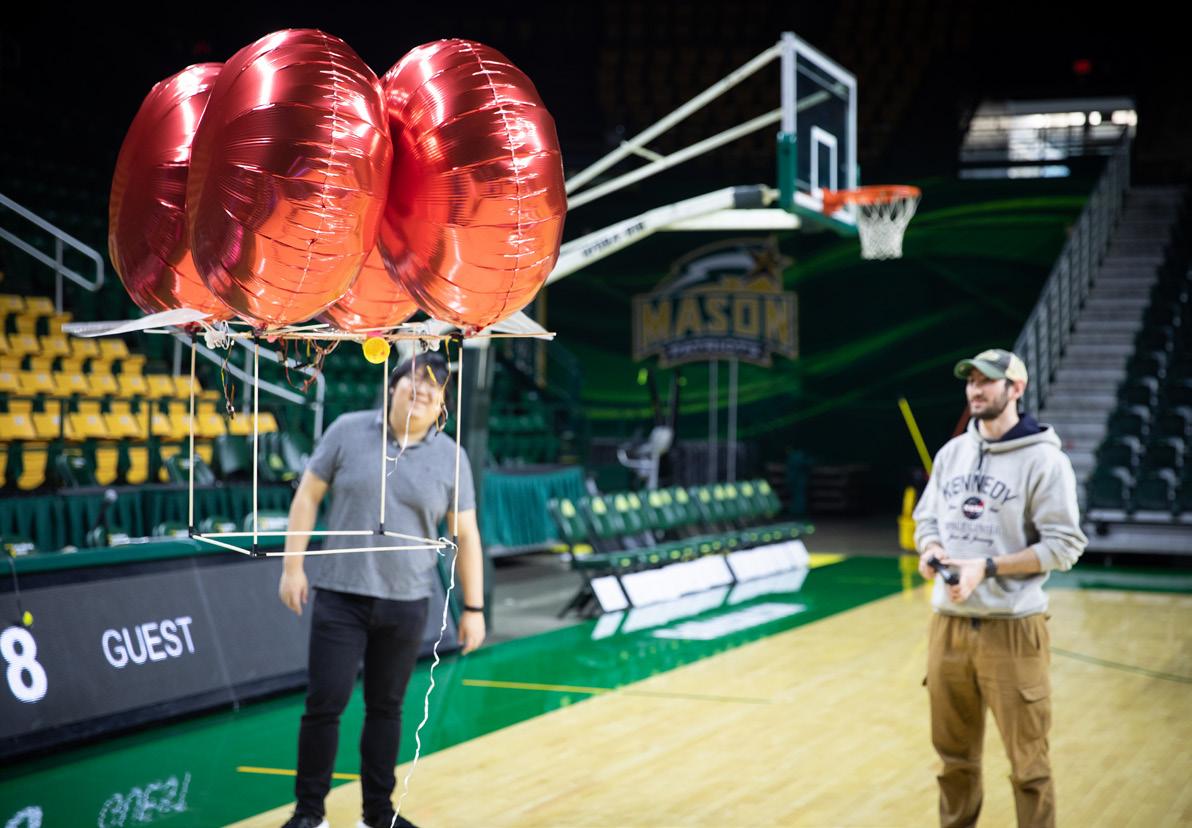
8 RESEARCH OF CONSEQUENCE
passion+ creativity

9
an origamiantenna

10 RESEARCH OF CONSEQUENCE
The resilience of 5G communications in the face of interference and intentional jamming is critical in certain situations, such as when malicious actors try to disrupt communication between U.S. military entities. Faculty member Kai Zeng, an associate professor is part of a multi-university research project to develop what is being called “Next G” and “Future G” to ensure those communication channels work seamlessly in the face of adversity.

5G millimeter wave (mmWave) technology uses particular frequencies for wireless communications, allowing for more capacity and speed. Like any other communication capability, however, mmWave signals can be susceptible to interference. Zeng’s research uses various techniques to ensure seamless communications.
Imagine an aircraft carrier sending a message to an airborne drone, but that signal being disrupted by an enemy aircraft in the vicinity, “jamming” that message. If the signal can be pointed in a different direction, where it can bounce off a reconfigurable intelligent surface (RIS), the signal can be re-routed around the jamming attempt. The 3D-printed, eggbox structure of the RIS—a fancy way of saying it is “an origami antenna”—allows it to generate multiple beams at wide angles, avoiding jamming. The antenna can adjust its frequency dynamically as needed.
In addition to the elaborate antenna, the research includes other attempts to thwart jamming, including using frontend technologies and digital filters, a maneuvering Zeng refers to as a “chess game.” He notes that malicious actors deploy learning-based jammers that can
Faculty Firm Up Future G
react to efforts to evade jamming, but “we can adapt to the jammers’ behavior.” Checkmate.
Zeng said the research is important because the proposed technologies will significantly enhance the users’ communication capability and resilience in contested and congested radio environments. They will be useful for military communication and commercial and civilian usage to greatly improve spectrum efficiency and utilization in spectrum-sharing paradigms.
This project is funded by the Office of the Under Secretary of Defense, Research, and Engineering. It extends our university’s research leadership in the field of wireless communications and future G technologies. Zeng has other ongoing research in the field, including a project funded by the National Science Foundation and Department of Defense on securely operating through 5G infrastructure, named “Windtexter,” which improves message encryption and covert communication.
antenna 11
Missy Cummings Seeks to Address Challenges in AI
According to Missy Cummings, director of the MARC, we have a national security crisis across the Department of Transportation, the Department of Defense, and many other government agencies.
“We have a genuine technical illiteracy problem. It’s not that people can’t understand AI. It’s that people are just not being educated in how AI is constructed or in its limitations,” she said.
Cummings encountered tech illiteracy problems earlier in her career while serving on the Defense Innovation Board.
“I saw the problem then, and now that I’ve been in the Department of Transportation, it’s doubly reinforced my concern about people’s limited understanding of AI,” she said.
Cummings wants industry and government employees to know how to ask the right questions about performance weaknesses and understand where to invest tax dollars.
She said she’s concerned the U.S. doesn’t have an effective workforce when it comes to understanding, managing, acquiring, evaluating, and testing AI. She wants people to learn about the right way for humans and AI to work together as well as to learn what is truly attainable and what is merely hype.
“I think traditional academia has a hard time accepting new areas, like a degree program in the design and deployment of AI. Older schools with more ingrained traditions struggle to embrace newer thinking,” she said. “I don’t think Mason is like that. Dean Ken Ball and others at the college as well as Mason’s president Gregory Washington have embraced these ideas.”
“Missy’s knowledge and experience surrounding AI are going to be a phenomenal asset to Mason,” Ball said. “Her ability to make connections between computer science, electrical, and mechanical engineering fields and leverage the strengths of each to improve our understanding of AI will be a game changer. We are thrilled she has decided to work with us.”
Cummings is proposing a new degree program in AI that will target engineering students as well as those in policy, law, and public health. “To navigate the world of AI, students also need softer skills in policy, and maybe even ethics,” Cummings said.
“I find that Mason is far more flexible and more open to new ideas than older more entrenched schools. At Mason, people are willing to come together from the different colleges and schools to solve real complex sociotechnical problems,” she said. “There’s not one societal problem we have today that belongs to a sole discipline.”
Her faculty appointment spans three departments— Computer Science, Mechanical Engineering, and Electrical and Computer Engineering. She will also be the First American Bank Endowed Chair, in addition to her role as director at MARC.
12 RESEARCH OF CONSEQUENCE
navigate AI

13
TTIP
The ambitious goals of the Commonwealth’s Tech Talent Investment Program (TTIP) include garnering an additional 25,000 graduates in computer science, computer engineering, and software engineering over the next 20 years. To help meet these goals, the department has a three-part strategy to increase the number of graduates from its Master of Science in Computer Engineering (CpE) program.

Establish a Bridge Program for Non-majors Interested in an ECE Master’s
1Associate Professor Tolga Soyata is developing a bridge program for fall 2024, to prepare undergraduate students in different technical majors for the master’s program in CpE. These students may have a good core background but would be missing certain electrical and computer engineering knowledge. If, for example, a student majoring in chemical engineering wants to pursue a master’s in computer engineering, that student would be able to apply to ECE’s bridge program. They will be able to earn a certificate in necessary supplemental background coursework, delivered asynchronously but with a substantial number of live office hours, before proceeding to the CpE master’s program. Soyata describes this as a professional graduate certificate in Embedded Computing Systems.
“They (students) would have to take five courses to get that certificate,” he explains, adding, “Once they have that certificate, we will count that towards the gaps in [their] undergraduate [studies], so that now we can admit [them] to the master’s in computer engineering.”
14 EDUCATIONAL INITIATIVES
Ramping Up Support for Tech Talent Investment Program
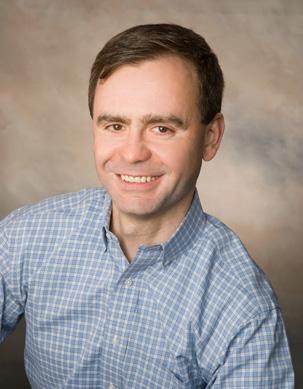
Offer Qualified Applicants Direct Admission
2
Graduate admissions will begin offering direct admission to the students who have applied to the MS in Computer Science (CS) program but are more suitable for MS in CpE. Soyata, who is the TTIP coordinator for the department, said that many applicants may not clearly understand the difference between computer science and computer engineering. Therefore, the department is collaborating with the Department of Computer Science on matching candidates with which master’s program to pursue. “In the end, regardless of whether the applicant goes to the computer science or computer engineering program, from a TTIP standpoint, they are going to count towards TTIP numbers, which is a CEC-level goal,” Soyata said.
Promote BAM Program to Undergraduates
degree and the Computer Engineering master’s degree. The program requires that undergraduates have at least a 3.0 GPA as juniors. Soyata suspects the BAM program is the best way to encourage in-state enrollment in graduate programs, as undergraduates may be encouraged to tack on a graduate degree to their academic careers. After all, students who graduate with 12 credits toward a master’s degree only need an additional 18 credits for degree completion. This could be accomplished in two semesters.
3
ECE’s third effort towards TTIP goals involves building awareness of the department’s Bachelor’s to Accelerated Master’s (BAM) program. ECE Associate Director, Undergraduate Studies and Advising Smriti Patwardhan has headed up BAM awareness efforts, and, with the recent introduction of the TTIP program, Soyata has joined her.

The BAM program allows undergraduates majoring in Computer Engineering up to12 credits of graduate-level classes during their senior year. Those credits can be applied to both the Computer Engineering bachelor’s
“A lot of our students work and pursue their BAM degree,” Soyata said, noting some of those students find employers willing to defray the cost of an additional two semesters of graduate school. Soyata adds that many ECE master’s classes are available in person—at both the Fairfax and Mason Square Campuses—or as distance learning courses, which affords students additional flexibility.
15
Tolga Soyata Smriti Patwardhan
New Clean Room and Microfabrication Concentration
ECE is thrilled to include new coursework that positions the department at the helm of nanotechnology innovation.
Through the work of Professor Qiliang Li, the department offers a Clean Room and Microfabrication concentration. This concentration is an important part of nanotechnology, which looks at ways of manipulating matter and atoms to create new structures and dimensions. At the intersection of science and engineering, nanotechnology is seen as an increasingly needed component in AI developments.
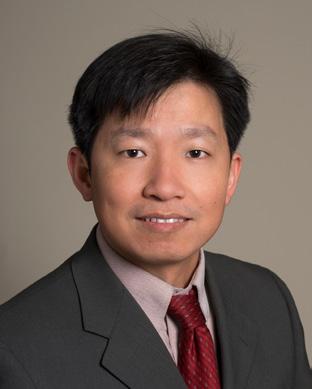
“Nano-IMAGINE is an important element of the Commonwealth’s efforts to build that workforce. We are very excited and proud to lead NanoIMAGINE with our partners on behalf of the Northern Virginia community.”
Clean rooms are generally enclosed environments with temperature, humidity, and lighting closely controlled. The rooms are an imperative part of nanotechnology processes to make sure matter is handled appropriately.

CEC and Mason support the development and progression of the nanotechnology workforce through this new concentration and the NanoIMAGINE initiative, which works to position the state of Virginia as a global nanotechnology leader.
“As the U.S. moves to reestablish its global leadership in micro- and nano-electronics, having a sizeable workforce able to design and fabricate electronic chips is vital,” said CEC Dean Ken Ball. “Nano-IMAGINE is an important element of the Commonwealth’s efforts to build that workforce. We are very excited and proud to lead Nano-IMAGINE with our partners on behalf of the Northern Virginia community.”
Nano-IMAGINE 16 EDUCATIONAL INITIATIVES

17 Nano-IMAGINE initiative
interdisciplinary

18 EDUCATIONAL INITIATIVES
Data Center Engineering
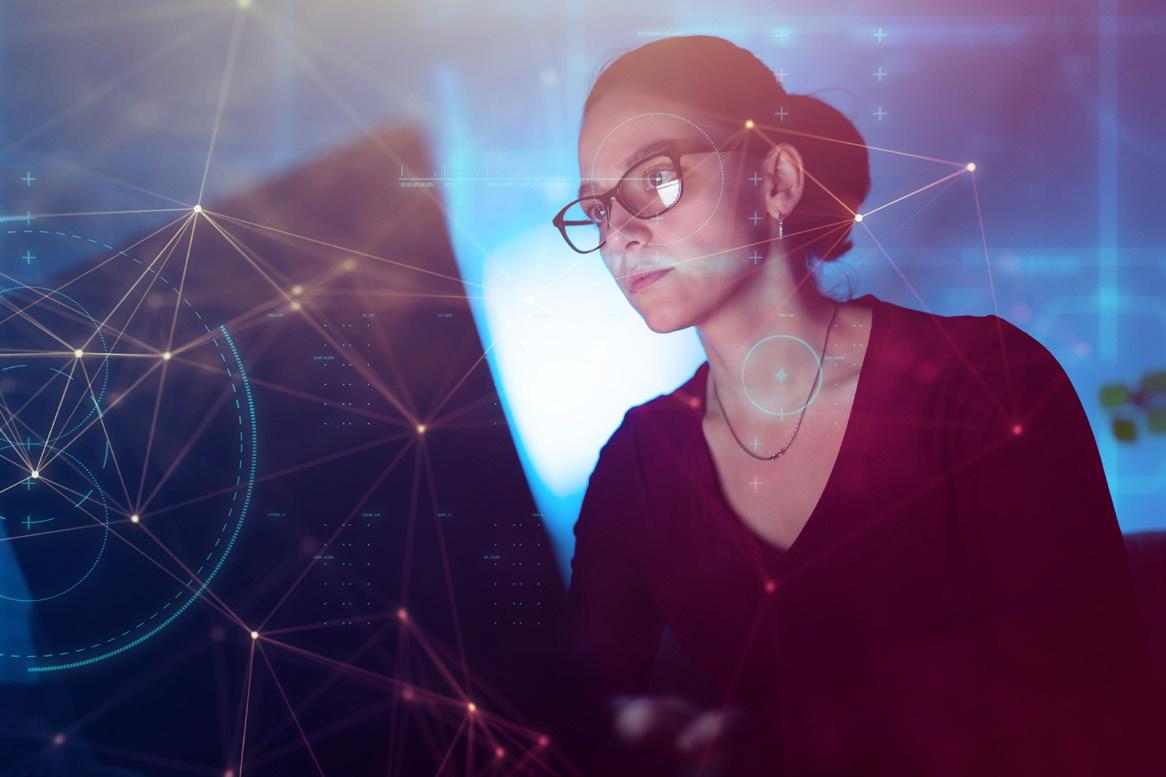

Northern Virginia is home to data centers for government and industry. Visitors to Loudon County can see dozens of these buildings as they head west from Fairfax. In fact, according to the Virginia Economic Development Partnership, Virginia hosts the largest data center market in the world and Northern Virginia is home to more than 20 percent (100) of all known hyperscale data centers worldwide.
In the next several years the department is taking on the challenge of meeting critical demands in the field of data center engineering. Data center engineers support a business’s data center, mainly working with servers and hardware infrastructure to ensure reliable backups. This service is vital for the day-to-day running of a business, from telecommunications to IT capabilities. The department is developing an interdisciplinary capstone project with Mechanical Engineering and is looking to create a concentration in partnership with Amazon Web Services.
interdisciplinary
19
“We are excited to partner with Amazon and to bring more opportunities for our students to learn, grow, and prepare to become part of the expanding data center engineering industry in Virginia.”
–Professor and Associate Chair Pelin Kurtay
Representatives from more than 50 companies met with students at the 2023 Industry Mixer held in the Johnson Center’s Dewberry Hall. The event had a two-fold objective: to introduce our current students to our alumni and industry partners and provide them with an opportunity to learn about various potential career paths, and to offer employers exposure to the next generation of engineers who are actively seeking internships and entry-level jobs.
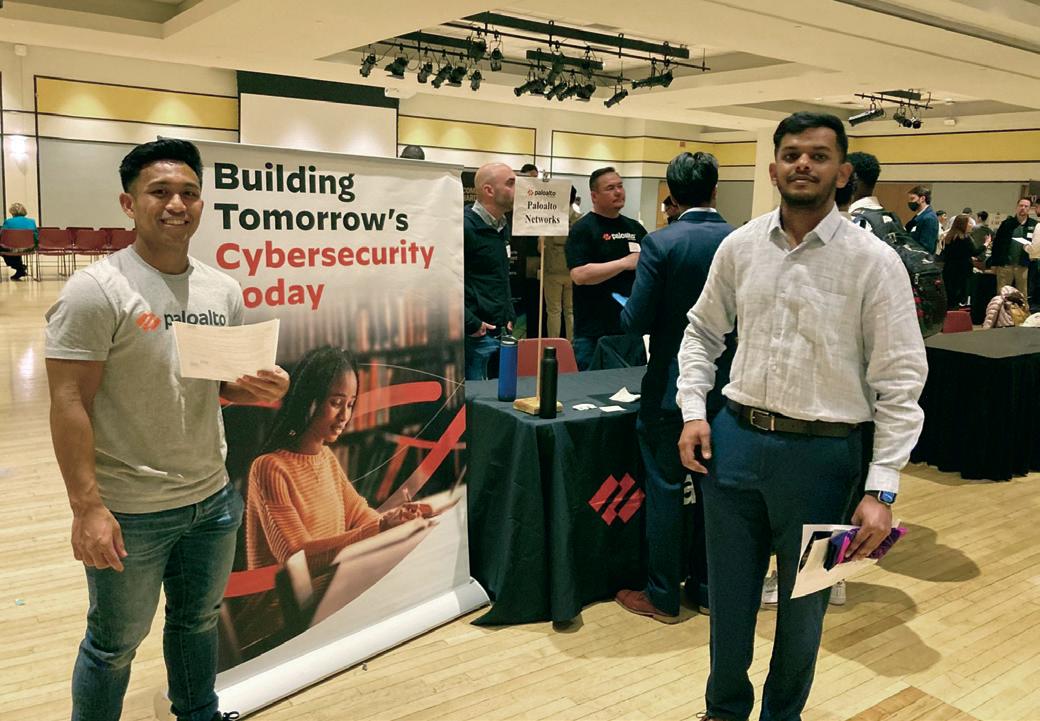
A Recipe for Success: Mixer Blends Students, Alumni, and Industry Leads
Companies in attendance included Dominion Energy, NOVEC, Amazon, Micron, Google, Sony, Airbus, BAE Systems, MITRE, Raytheon, Deloitte, General Dynamics, and more. Company representatives took up positions at booths spread throughout Dewberry Hall and mingled with students who introduced themselves and presented their resumes. Many students were recruited for internships and permanent positions for a variety of jobs in fields ranging from hardware design and testing, computer forensics, power systems, cloud services, and software engineering.
Representatives from companies included several alumni who shared insight into what their employers were looking for and who they were looking to recruit. Judging by the lively conversations and the number of resumes and business cards exchanged, the evening was a huge success and the department plans to continue the tradition in the future.
20 EDUCATIONAL INITIATIVES
Complete list of companies:
Accenture
Advanced Geosolutions Inc
Airbus Amazon
Amplus Corporation
BAE Systems
Black Horse Solutions, Inc.
Booz Allen Hamilton
CACI International Inc
CoAspire
Comcast Corp
CVS
Deloitte
Dominion Energy Inc
Dorabot Inc.
ECE Federal
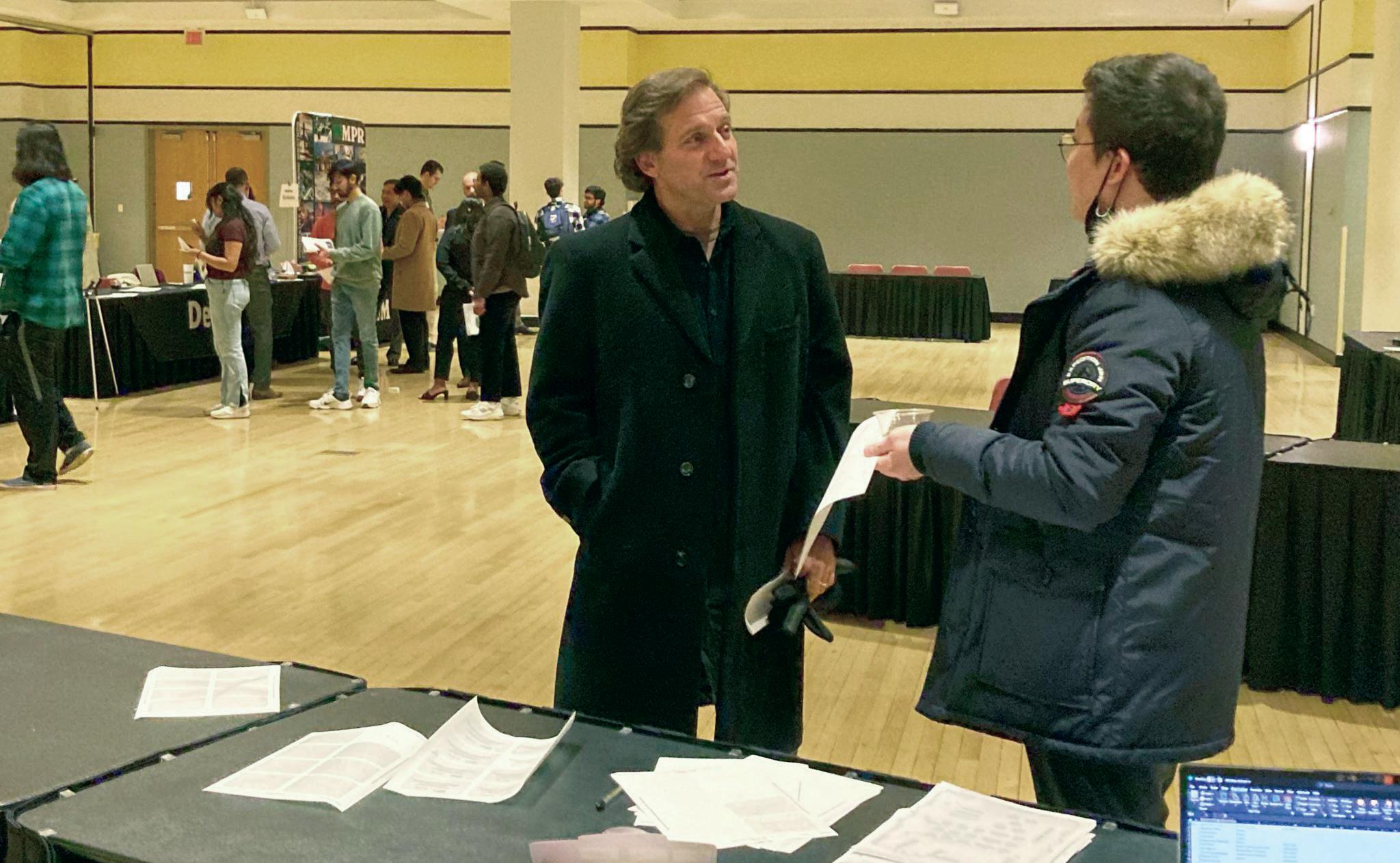
Fairfax County Water Authority
General Dynamics Corp
Google
Groundswell
Iron Vine Security, LLC
Jacobs Enforcement
John Hopkins Applied Physics Laboratory


JPMorgan Chase & Co
L3 Harris
Leidos
Lockheed Martin Corp
M.C. Dean, Inc.
Metron
Micron Technology
MITRE Corporation
MPR
Naval Surface Warfare
Center Dahlgren Division
NetImpact Strategies
NGS
North American Substation Services
Northern Virginia Electric Cooperative
Northrop Grumman Corporation
NOVEC
NVR, Inc.
Oak Ridge National Laboratory
Oceaneering International
Ofinno
Perspecta Labs
Probity
PwC
Quanta Technology
Raytheon
Rhein Tech Laboratories Inc
Sony Corporation
TechSet
Trident Systems Inc.
Two Six Technologies
U.S. Immigration and Customs
Enforcement
U.S. Naval Research Labs
Verizon
WISEPRO
Yahoo
Zansors
21
exceptionalacademic
Peter Pachowicz said he knew nothing about Lina Alkarmi when he received Alkarmi’s resume and request to talk about research opportunities.
But Pachowicz, an associate professor of electrical and computer engineering in the college, said it took only a short conversation to know Alkarmi, who had recently changed her major to electrical engineering, would be a valuable partner.
“At my age you can identify people quite easily who are ambitious and who will excel in the future,” Pachowicz said. “So a short discussion and I already knew she was the right person.”
Pachowicz isn’t the only one who sees Alkarmi’s potential, as the junior from Sterling, Virginia, and a member of Mason’s Honors College, has received a prestigious Goldwater Scholarship, which is available to sophomores and juniors pursuing careers in engineering, mathematics, and the natural sciences.

The award of $7,500 per academic year can be used for tuition, mandatory fees, books, and room and board. It is also a gateway for students applying to graduate schools and searching for research funding. Goldwater scholars also have access to previous winners, who serve as mentors.
“Oh, I didn’t really believe it,” Alkarmi, Mason’s 12th Goldwater Scholar, said of the award. “It was something I was hoping for, but not expecting.”
22 STUDENT ACCOMPLISHMENTS
Bold Move Puts Goldwater Scholar on the Right Path
The scholarship’s application process is extensive, and of the 1,267 students nominated in this cycle, only 413 received funding.
In addition to academic transcripts, students must list all research experience and write two essays, one describing their career goals and another on an activity that has been important in shaping their desire to pursue a research career. Students must also submit three letters of recommendation from faculty.
Alkarmi credited Mason’s Goldwater Committee—Karen Lee, assistant director of the Office of Student Scholarship, Creative Activities, and Research (OSCAR); Jan Allbeck, associate dean of the Honors College; and Joshua Davis, assistant professor of conservation biology—with helping craft her application.
“I actually worked with them a lot,” Alkarmi said. “They reviewed my essays probably five times and revised my applications. They even read my letters of recommendation to make sure they were good, so they were really helpful.”
Alkarmi didn’t start as an electrical engineering major, though electrical engineering is also her father’s profession. But after taking several math and physics classes, she wanted more. Besides, Alkarmi said, “electrical engineering explains so many things about how everything works, how the world works. You really go deep into everything and understand why, instead of just knowing, well, this exists but you don’t know why it works.”
Alkarmi’s work with Pachowicz centers around using lasers for optical calibration of ground telescopes. The plan is to build a satellite with two payloads having four lasers each. Once in orbit they will be a reference point for telescopes exploring exoplanets and engaged in other cosmology research.
“So instead of using a star [to calibrate a telescope], you can make your own star,” Alkarmi said. “That’s what the laser is, it’s a fake star that you know where it is and you can control the light coming out of it, so the calculations are a lot better.”
Pachowicz said he is waiting to hear if the project, which aligns with Mason’s mission to contribute bold initiatives to push research forward, will get funding from NASA.
Alkarmi’s job is to help fashion the laser controller, a challenging task, Pachowicz said, because of the thermal and radiation issues in space for which she must account.
For Alkarmi, it’s another step toward her ultimate goal of earning a PhD and teaching in higher ed.
“Lina embodies what it means to be a Goldwater scholar,” said Megan Bruening, Mason’s director of fellowships. “Her exceptional academic record and passion for pursuing research made her stand out among the hundreds of applicants that apply for the Goldwater every year.”
Said Pachowicz: “I would love to have many more like her.”
23
Aspiring to Smoother Traffic
There are few better feelings than hitting all green lights on your drive home. Brian Mark’s research aims to bring you that feeling more often. Ideally, technology can help you hit a “green wave” by keeping your car within an optimal speed bracket, said Mark, professor of electrical and computer engineering.
The increasing likelihood of autonomous vehicles on the road offers a prospect even more promising than the idea of creating an app for human drivers, originally proposed in joint work of Mark and Mel Friedman, a retired physicist from the Army Night Vision and Electronic Sensors Directorate in Fort Belvoir, Virginia. Through Mason’s Office of Technology Transfer, Friedman and Mark recently submitted a U.S. patent application on a method for coordinating traffic lights and reducing traffic congestion.
“It probably will work even better with connected and automated vehicles,” explains Mark, “so you know the car itself is programmed to keep on the green wave. Like, if you have to turn right, you might not be on the green wave; so ... you might have to catch up to the green wave ahead of you or slow down to catch the green wave behind you.”
Mark supervised a senior design project to move toward his goal sponsored by the Army Strategic Program for Innovation, Research, and Employment (ASPIRE). Three Mason Electrical and Computer Engineering department teams participated in ASPIRE, supervised by Qiliang Li, Brian Mark, and Cameron Nowzari, respectively. As part of the
program, in addition to several Zoom meetings, the seniors attended a spring meeting at Fort Belvoir, Virginia, where they presented their project progress.
Mark’s ASPIRE team constructed a model of a connected and automated vehicle. Sara Sulaiman Alaraini, Colin Graves, Corey Jones, Nitin Mandadi, Andrew Mokhtare, and Adham Obeid modified a remote-control vehicle to operate autonomously on a tarp designed like a road system, complete with centralized traffic light–controlled intersections. The team outfitted the car with sensors, a camera, and arUco tags to help it stay oriented in its environment.
“The traffic lights are connected to a centralized server, and the car is able to automatically stop at a traffic light and then go when it turns green,” said Mark.
“Through the centralized server you can indicate the destination...It will automatically calculate the path through the street grid, and the car will just go to that destination and obey all the traffic lights as it goes.”
Mark hopes a future senior design team can further extend the project by incorporating multiple cars to simulate traffic scenarios.
“The next project would be if you have a bunch of cars. And they’re all following green waves, so that they’re all obeying the traffic lights. But they never really have to stop unless they have to turn. That would be the ultimate demonstration of this concept,” said Mark.
hit 24 STUDENT ACCOMPLISHMENTS
hit a “green wave”

25 25
best senior design award
Engineering for Good: Students Design a System to Detect Landmines
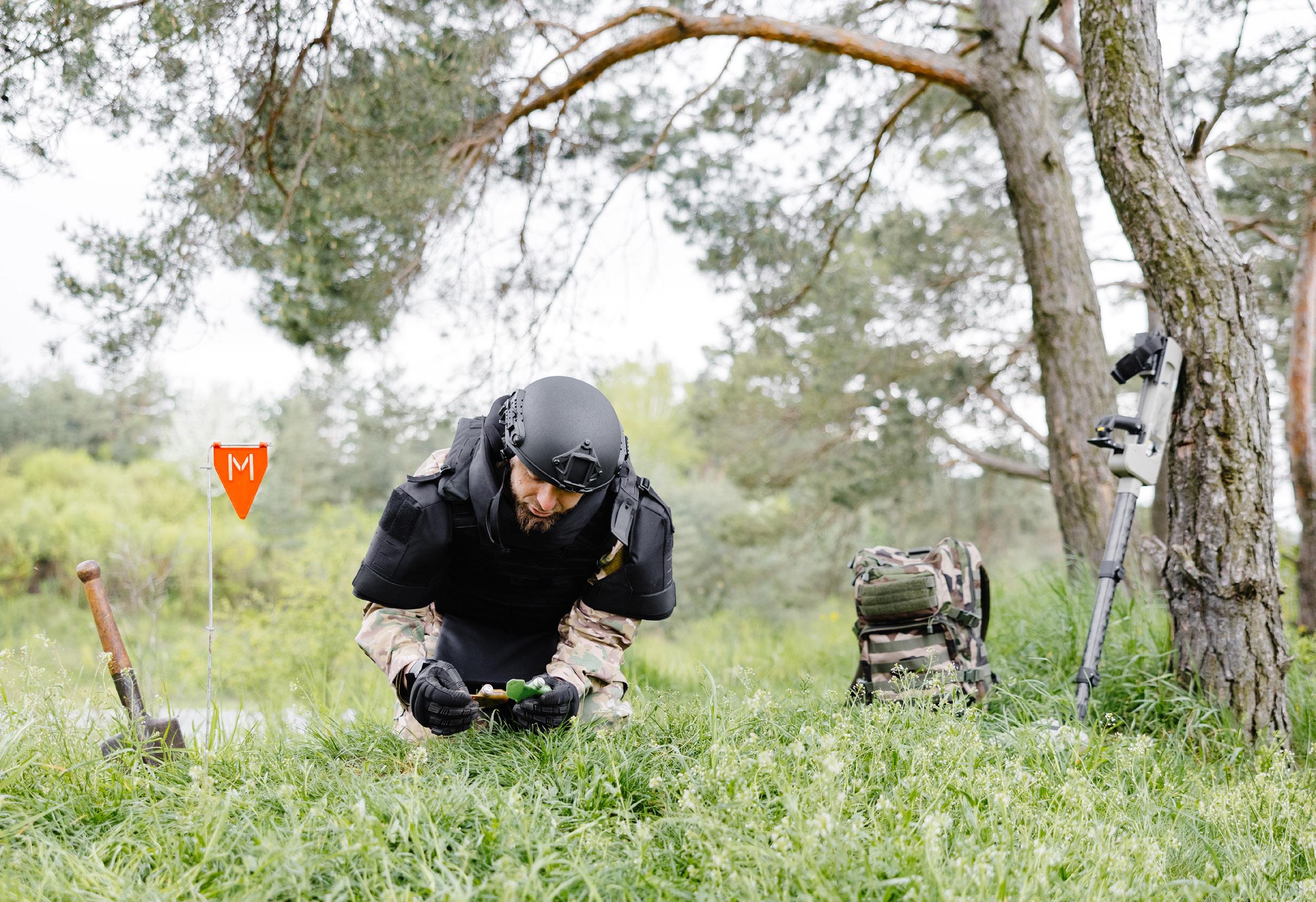
Through working on environmental projects from preventing wildfires to detecting landmines, the humanitarian goals of senior design team projects led by Professor Qiliang Li have drawn acclaim in the department.
“We want the students to take care of and to care more about humanity, to consider how we can apply engineering and technology in more constructive ways [such as] saving lives,” said Li. This year, his team tackled a compelling question: “How can we clear landmines so that people can go back to their own land and are able to live in their place, their homeland?”
Li saw this year’s project as an opportunity for students in his electromagnetic theory class to apply the information from his class, learn how to build a system independently, and consider the potential positive
26 STUDENT
ACCOMPLISHMENTS
societal impact of engineering. The team—Elise Treat, Grace Louise Gaudin, Isaac Lunsford, Mazeyar Amiri, Adrian Lange, and Sami Zahreddine—developed a synthetic aperture radar system with a low size, weight, and power system (Low SWaP SAR) to use Ground Penetrating Radar (GPR) to detect buried landmines.
“Their radar is basically sending an electromagnetic wave out to the land,” he explained. “They receive a wave from the refraction off the land off the surface and any object underneath the soil so by analyzing it, the students are able to detect the landmine.”
Along with teams led by Professors Brian Mark, and Cameron Nowzari, respectively, the project was sponsored by the Army Strategic Program for Innovation, Research, and Employment (ASPIRE), which afforded the team multiple opportunities to present their research to peers and experienced researchers. The team also presented within the department at the end of the academic year, the culmination of the yearlong project.
“The senior design capstone students put a lot of effort into building a project like this; they build hardware, and they write the software to drive the hardware as a system and then gather results. Then, they explain how they designed the system and how these results are important.
In other words, how these results are novel in comparison to ongoing research in the field,” Li noted. For the second year in a row, the senior design team working under Li’s guidance won the best senior design award in the department.

Li hopes future senior design teams will continue the research from this year’s project. This project is itself an extension of a prior team’s work. Li’s prior team used a large power radar system, albeit with different circuit designs for long distance remote sensing, to assess changing landscape morphology of say, a mountain being affected by a wildfire.
“Last year’s team was more focusing on objects on the land, above the land, for example, the woods and vehicles,” Li explained. This year, Li encouraged his team to focus on finding object under the ground that constitute a serious humanitarian problem: landmines left behind in old battlefields. This year’s team thus needed to focus especially on the refraction of light from soil.
Li hopes future teams will build off the work done this year by using radar to study soil quality to assist farmers.
“If you’re able to use radar carried by drones, you’d be able to help the farmer to detect the soil quality at a large scale. They would not need to go over there and take the soil and go to the lab and analyze the chemical composition,” he said.
senior award
27
try anything… once

28 EDUCATIONAL INITIATIVES 28 STUDENT ACCOMPLISHMENTS
Harry Potter fans might dream of flying through the sky in a Quidditch game. While Mason PhD student Dinesh Karri, MS Electrical Engineering ’19, isn’t personally reaching new heights in a Quidditch match, his team’s technology is.
Three years ago, Karri started working with his academic advisor, Professor Cameron Nowzari, on an LTA project funded by the ONR. The goal—develop a minimally viable swarm of robots that can safely maneuver and achieve their mission in a unique environment. ONR supports this project at universities across the country, and teams all meet up at the biannual Defend the Republic game to test their new technology, learn from each other, and compete. “It’s a great chance to see what other people came up with. It’s always different than what your team thought of,” said Karri.
BACK TO BASICS: To create minimally viable robots, Karri said it’s best to keep it simple and stick to the basics. “At one of the Defend the Republic matches, I learned about how a team uses basic timers in a clever way to achieve the objective. It was so interesting,” said Karri. It may seem counterintuitive to have dumb robots, but in the case of Karri and his LTA shark blimp team, the simpler, the better.
THE BEST ADVICE? FAIL FAST: Nowzari gave Karri some of the best advice that he employs both inside and outside the research lab. “Learn first, test fast, fail fast, and get better,” said Karri. “I’m not sure if he meant it to be such impactful advice, but for me, it is.” In research, things rarely go as planned the first time around. But if you keep waiting for everything to be perfect, or you’re afraid to
Student Profile: Dinesh Karri
even try, you won’t be able to learn. “You can’t know what’s wrong until you test your work,” Karri said. Even if a test fails, he believes he is still that much closer to the solution.
DOING HIS HOMEWORK: Karri came to the United States from India in 2017 to attend graduate school. He said he applied to Mason because it offered robotics and was in the Washington, D.C., area, but his research did not stop there. “I reached out to a lot of alumni to get information on the educational prospects, and I got a very positive response, which pushed me toward choosing Mason.”
THE QUALITY OF THE QUESTION: Karri admits that his PhD has been a rollercoaster ride, and sometimes the lows outweigh the highs. However, through it all, his mentors have taught him that even when the ride seems to be going off track, you’re still learning. “You’re always learning how to ask quality questions and find new ways to answer them,” he said. “When I started my research, my professors let me ask some dumb questions, but they never saw them that way. They always gave me a chance to learn.”
TRY ANYTHING…ONCE: Karri thinks everyone should take the opportunity to try new things, and with the large number of student organizations available at Mason, he’s found a few of his hobbies by simply saying yes. Dancing, ping-pong, chess, and cricket are a few of his passions. “Try new things and stick with what you like,” he said.


DEPARTMENT OF ELECTRICAL AND COMPUTER ENGINEERING George Mason University Nguyen Engineering Building, Room 3100 Mail Stop: 1G5 4400 University Drive Fairfax, VA 22030 703-993-1569 ece@gmu.edu ece.gmu.edu



 Electrical& Computer Engineering
Electrical& Computer Engineering




























